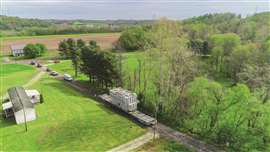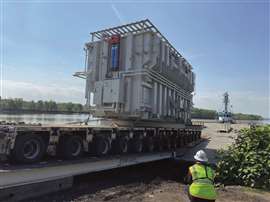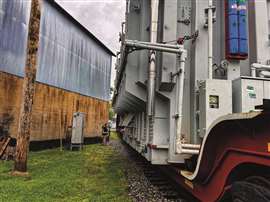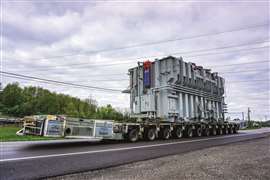Edwards hauls transformer from Belgium to backroads of Ohio
11 July 2023
A long-time customer recently reached out to Edwards Moving & Rigging about a particularly challenging heavy haul. One of the customer’s large transformers at a generating station in Southern Ohio had failed. The only transformer they were able to locate in short order to replace the failed unit was a massive transformer located in Belgium.
 The replacement transformer measured 36 feet by 17 feet 9 inches by 17 feet 2 inches and weighed 562,179 pounds.
The replacement transformer measured 36 feet by 17 feet 9 inches by 17 feet 2 inches and weighed 562,179 pounds.
The transformer that was needed rather urgently was an ocean away. While the ocean transit and river journey were relatively straightforward, the challenge was getting the transformer from the barge landing to the plant.
Pursuing every option
Edwards began pursuing every option feasible to get the transformer – which measured 36 feet by 17 feet 9 inches by 17 feet 2 inches and weighing 562,179 pounds – from the barge landing in Marietta, OH, to the plant. At the end of the day, every conceivable highway possibility for the road transport of this transformer was presented to the Ohio DOT, but all were turned down due to infrastructure limitations on the travel path. The Edwards team simultaneously explored rail options, and after some initial struggles, finally found a solution that combined highway travel with rail transport that would get the much-needed transformer to the pad and installed.
 To power the weight of the load up the hills, Edwards shifted to a different configuration, putting two PST modules back-to-back into a 12-line system with a total of 980 horsepower and started toward the substation.
To power the weight of the load up the hills, Edwards shifted to a different configuration, putting two PST modules back-to-back into a 12-line system with a total of 980 horsepower and started toward the substation.
“Our customer was optimistic enough that we would find a route that they went ahead and procured and shipped the transformer prior to final authorization from all the necessary entities,” said Tobias Epple, Edwards’ director of business development.
At that point, the Edwards team started looking at a “river to road to rail to road to pad” journey. As the details from Marietta to the site were being finalized, Edwards shipped grillage to New Orleans and received the transformer onto a deck barge. As the transformer progressed up the Mississippi River, then turned onto the Ohio River toward Marietta, the Edwards team continued preparations, getting the rail car en route to the transload area along with the shipment of equipment needed to facilitate the transport.
The plan involved crossing a busy state highway to get the transformer from the barge landing to the rail siding. Edwards utilized a four-file Goldhofer to get the weight to an acceptable level for the state DOT requirements. Since the transformer was rolled off the barge on a 15-line two-file PST, after the roll off, the Edwards team lowered the unit to staging, then added the extra 15 lines to form the four-file set-up and meet the permit specifications.
 After some initial struggles, the Edwards team finally found a solution that combined river barge, highway travel and rail transport that would get the much-needed transformer to the pad and installed.
After some initial struggles, the Edwards team finally found a solution that combined river barge, highway travel and rail transport that would get the much-needed transformer to the pad and installed.
The Edwards team then transported the transformer approximately a mile and a quarter to the rail siding. After transloading the transformer via jack and slide, it was tied down and railed to the Waterford, OH area.
Route problem
It was at this point, the Edwards team had to deal with another big challenge – a narrow and winding route with two grades up to 18 percent.
To power the weight of the load up the hills, Edwards shifted to a different configuration, putting two PST modules back-to-back into a 12-line system (with a total of 980 horsepower) and started toward the substation. The Edwards team navigated the narrow, winding, up-and-down route safely, and the transformer was staged near the pad to allow for some initial installation of accessory components. The Edwards crew returned several days later to the site to slide it over the pad and set it to the designated markings from the customer.
 Every conceivable highway possibility for the road transport of the transformer was presented to the Ohio DOT, but all were turned down due to infrastructure limitations on the travel path.
Every conceivable highway possibility for the road transport of the transformer was presented to the Ohio DOT, but all were turned down due to infrastructure limitations on the travel path.
“Edwards entire team from the sales team all the way to the on-site operations, embraced the challenge of this project and provided an important customer with the quality and service they have come to expect from a company with 60-plus years of experience in the industry,” said Epple. “The project was completed safely with no injuries or incidents of any kind. Edwards could not have asked for smoother interaction and competent assistance from our partners at Ceres Consulting, SRT and VIP, a local short line railroad.
From Belgium to the backroads of Ohio, the Edwards team made it happen.




